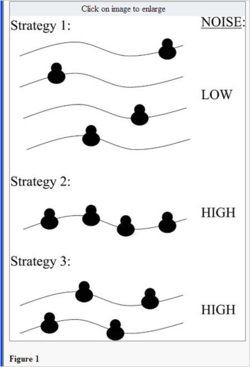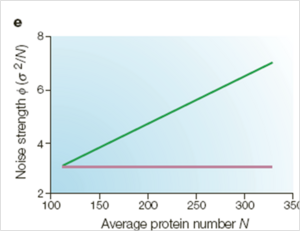Translational Bursting
Translational Bursting is the Main Source of Stochasticity in Prokaryotes
The amount of protein translated per strand of mRNA produced is characterized as a transcript's translational efficiency or "burst parameter". Proteins are translated from mRNA in a pulsatile manner often described as "short bursting". Genes that are regulated by operons with low translational efficiency have a lower amount of noise than those exhibiting high translational efficiency. This is because a lower amount of mRNA in the cell means that the concentration of mRNA's are more susceptible to stochastic events such as mRNA degradation or binding of transcription factors.

Figure 1 obtained from http://www.pubmedcentral.nih.gov/articlerender.fcgi?artid=400249 permission pending
Figure 1 visually depicts the varying levels of noise in response to varying levels of mRNA and translational efficiency. Due to the stochastic nature of translation, larger concentrations of mRNA result in less stochasticity as a result of translational machinery.
Results
While the finite number effect is the most recognized source of stochasticity in gene expression, translational bursting is the most prevalent.

Figure 2 depicts The dependencies of noise and noise strength on the average protein abundance when transcription rate (size of system) and translational efficiency are increased in a prokaryotic cell. The green line represents the varying translational efficiency and the pink line represents the varying transcriptional rate. When comparing the slopes of the lines in figure B, translational efficiency has a much greater effect on noise strength. Find out why in the next section.